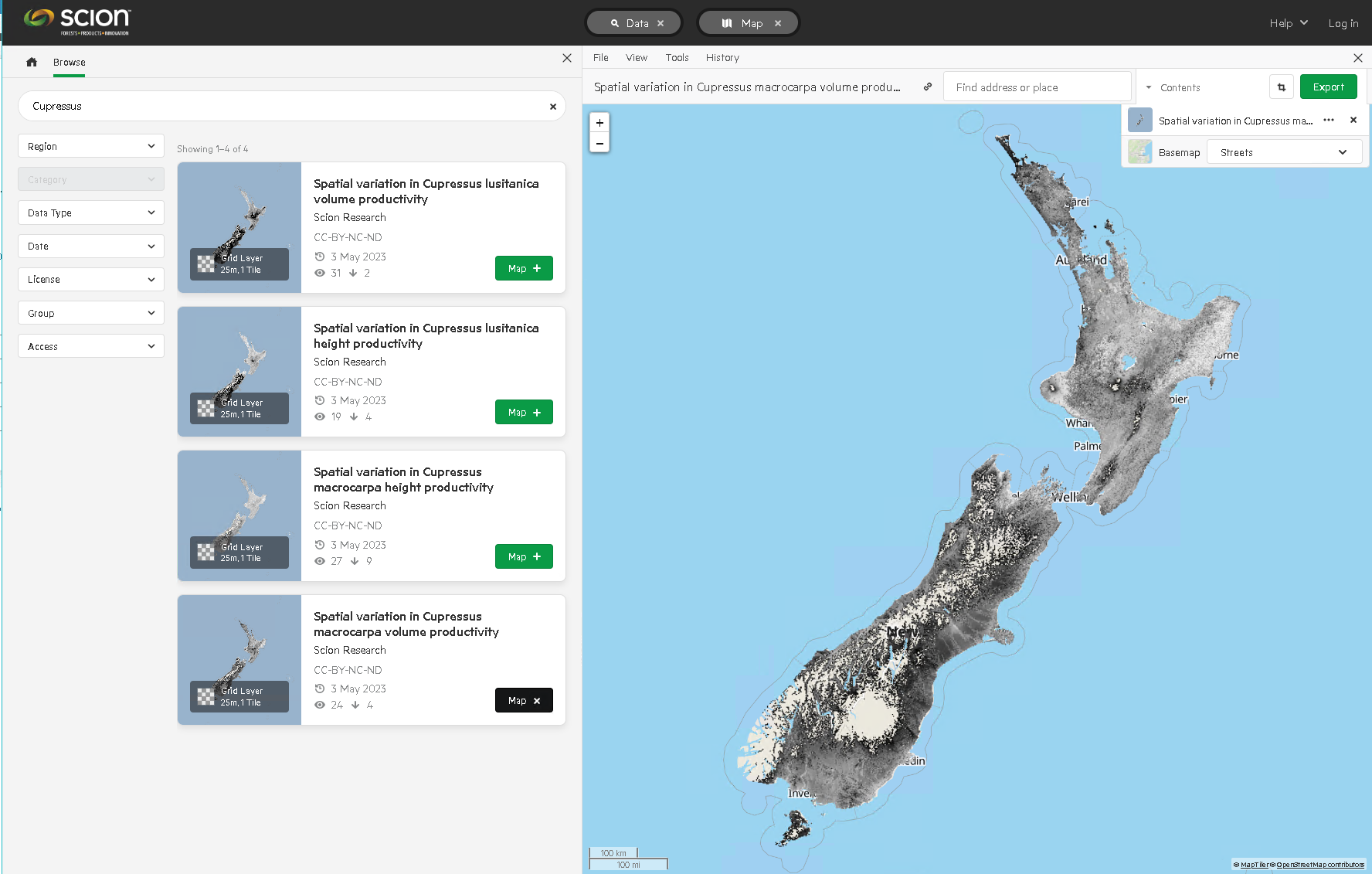Description
Spatial productivity indices for Cupressus macrocarpa and Cupressus lusitanica which can be used as inputs to a cypress growth model Kimberley and Watt (2023) for predicting stand volume.
- Volume productivity is defined by the 300 Index which is the mean annual volume increment at age 30 normalised to a stand density of 300 stems/ha, with units of m3/ha/yr.
- Height productivity is defined as Site Index (units are metres) which is the mean top height at age 30 years, where mean top height is defined as the mean height of the 100 largest trees, by diameter.
Date: May 2023 Version: v1
Owner: Scion
Contact: Michael Watt, Scion
Link to report / paper
Watt et al (2023)
Preview Image

Dataset attributes
| Spatial extent |
National. Large lakes and extremely cold or wet areas with very low predicted productivity were masked. |
|---|
| Spatial resolution |
Productivity surface developed at 25m resolution. |
|---|
| Temporal extent |
The Permanent Sample Plot data used represents stands planted from 1936 to 2006 under prevailing growing conditions. |
|---|
| Temporal resolution |
Not applicable. (Growth models generally annual time-steps with some monthly sub-routines). |
|---|
| Evaluation method (Validation) |
One-at-a-time validation. |
|---|
| Evaluation result (Numeric) |
The regression models for C. lusitanica were unbiased and had high precision for both 300 Index (RMSE = 2.48 m3 ha−1 yr-1; R2 = 0.75) and site index (RMSE = 1.78 m; R2 = 0.84).
The C. macrocarpa regression models had high precision and were unbiased for both 300 Index (RMSE = 2.86 m3 ha−1 yr−1; R2 = 0.72) and site index (RMSE = 1.86 m; R2 = 0.81). |
|---|
| Evaluation result (Categorical) |
|
|---|
| Uncertainty method |
|
|---|
| Uncertainty data format (Numeric) |
|
|---|
| Uncertainty data format (Categorical) |
|
|---|
Methodology
Using a national dataset (n = 156 observations for C. lusitanica and 134 for C. macrocarpa) a multiple regression model was used to predict productivity indices from environmental surfaces and this model was used to produce the displayed map.
A detailed description of the modelling methods and results is given in: Watt MS, Kimberley MO, Steer BSC, Holdaway A. Spatial comparisons of productivity and carbon sequestration for Cupressus lusitanica and macrocarpa within New Zealand. Forest Ecology and Management 2023. 536.
The growth model is described in Kimberley MO, Watt MS. Growth Models for Even-Aged Stands of Hesperocyparis macrocarpa and Hesperocyparis lusitanica. Forests. 2023; 14(1):105.
Fitness for purpose / limitations
This table indicates whether the dataset is suitable for different types of questions at different scales.
Note: Users should carefully consider their purpose as this dataset may not be suitable.
|
Operational
| Absolute
| Relative
| Screening/scoping
|
| Block/farm |
No | No | Maybe | Yes |
| Multi-farms(5+) |
No | No | Maybe | Yes |
| Catchment |
No | No | Yes | Yes |
| National/regional |
No | Maybe | Yes | Yes |
Caveat(s) |
The presented surfaces are intended only as a guide for afforestation and growers should take into account the impact of microsite when choosing an appropriate species. These surfaces were derived from permanent sample plot data, which typically comprise plots of well managed trees, that do not have any unstocked areas and are sited away from exposed ridges. Consequently, we recommend that presented values of 300 Index and Site Index are reduced to allow for the unstocked component of typical forestry sites. |
